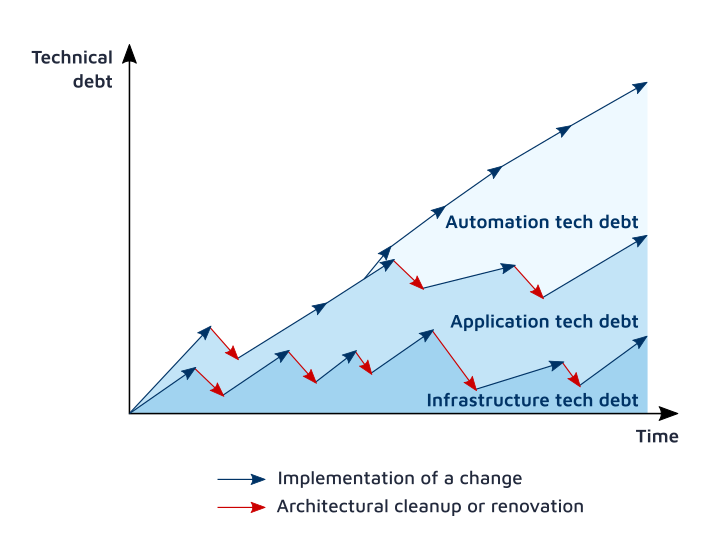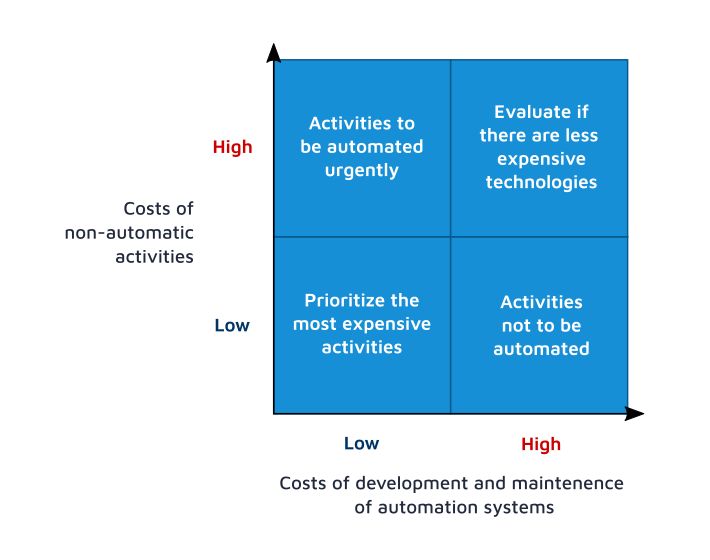Platform Strategy and Microservices: how to avoid Automation Debts

Automation and Technical Debt
The automation of enterprise digital processes is an activity that is increasing at the rate of almost 13% per year[1] , due to the growing need of companies to decrease costs and increase efficiency, offering customers engaging seamless online experiences even if the business systems are different.
However, if not well managed, the automation of activities can lead to an increase in technical debt, which can account for 20% of the IT budget[2] .
According to Forrester[3] , if not carefully evaluated and managed, the introduction of a new technology, such as RPA (Robotic Process Automation) can add an Automation Tech Debt to the Technical Debt already present in the company, formed by the sum of infrastructures and an application’s technical debts.

Source: "How To Avoid The RPA Investment Mouse Trap” Forrester
Automation Debt and Automation Debt Ratio
But the technical debt is not the only cost a company may face. There is also an Automation Debt[4] , which is the opportunity cost given by not having automated activities that can be made automatic.
This debt, in addition to weighing on the shoulders of the employees in the company, who must complete the activities without technological support, also affects the competitiveness of the company, especially if the context is very sensitive to performance and innovation.
The weight in the company of the Technical Debt can be calculated through the relationship between the maintenance costs for IT systems and development cost[5] . It is possible to use the same system to understand the burden of Automation Debt by calculating the Automation Debt Ratio, or the ratio between the cost of non-automated activities and the cost of development (and maintenance) of automation systems. This coefficient is directly proportional to the urgency of automating activities, because as the ratio increases, the opportunity cost and therefore the loss of competitiveness in the company in its market coincide. We can therefore hypothesize four possible scenarios, obviously based on the period of use of the automation systems, which according to our experience ranges from five to 10 years.

How to avoid Automation Debt and Automation Tech Debt?
Completely avoiding Automation Debt is impossible, because it would mean being a fully automated company, or one that gives more importance to the automation of processes rather than other needs. It is certain, however, that the debt can be reduced by following the logic of the four scenarios seen above, being a company attentive to market innovations, costs, efficiency and giving priority to the activities that need to be automated more urgently.
In order to simplify the activity of innovation and automation, Low-Code platforms such as WebRatio Platform, are always updated with the latest automation innovations, with technologies, for example, BPA, DPA and RPA, come to the rescue.
Low-Code platforms offer features to avoid falling into the automation cost trap, according to Forrester[6] :
- Being able to follow a “Platform Strategy” instead of thinking about the single application, or having a complete view of the systems when developing automation, to simplify the structure and integration of the application with internal, external and future systems. Having a development strategy that takes into account all applications reduces the cost of maintenance, because it is possible to intervene on all systems involved in a change and only when necessary.
- Make sure that business processes are composable, that is, creating architectures with integrated microservices via APIs, instead of monolithic systems and redundant web services, which increase development and management costs.
Low-Code: Simplifying development reduces debt
We have seen how companies that do not automate activities accumulate debt compared to companies that adopt automation systems. However, if the technologies adopted are not carefully evaluated and managed, companies can increase their automation technical debt, which adds to the costs of information systems.
The languages, visual tools and configurators used in Low-Code platforms are suitable for simplifying and accelerating the creation of microservices and integrations via API, being able to create new automatic functions more quickly and return the development investment in just 6-12 months.
Ask for a free consultancy for Process Automation development >
Sources
[1] https://www.mordorintelligence.com/industry-reports/digital-process-automation-market
[2] https://www.webratio.com/site/content/it/dettaglio-notizie/technical-debt-soluzione-low-code
[3] “How To Avoid The RPA Investment Mouse Trap” Forrester, October 4, 2021
[4] https://www.forbes.com/sites/forbestechcouncil/2021/05/24/technical-debt-is-no-excuse-for-automation-debt/
[5] https://www.webratio.com/site/content/it/dettaglio-notizie/technical-debt-soluzione-low-code
[6] How To Avoid The RPA Investment Mouse Trap” Forrester, October 4, 2021
Latest Stories
Vibe Modeling: where AI meets Low-Code
From Cost Control to Continuous Innovation: The CIO’s New Balance
CIO priority for 2026: boosting productivity, including Low-Code
Tag
AllArtificial Intelligence - AI
BPA Development
BPM Software
Customer
Digital Transformation
Distribution & Retail
Energy & Utilities
Enterprise Applications
Finance & Insurance
IoT
LinkedIn Live
Low-code
Manufacturing
Mobile Development
Modernization
Partner
Shadow IT
Travel & Transportation
Web Development
WebRatio Platform